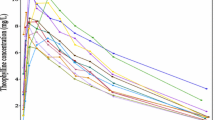Abstract
This paper deals with the deterministic identifiability of nonlinear pharmacokinetic models, namely, whether the model parameters can be identified with perfect data. It is shown that the most familiar method for analyzing the deterministic identifiability of linear models, in which the Laplace transform of the observation is examined, does not work for nonlinear models. An alternative method, in which the observation is expanded as a Taylor series about t=0,is described and is illustrated with some examples of nonlinear models familiar in the pharmacokinetics literature, in which an elimination rate is assumed capacity limited, with Michaelis-Menten kinetics.
Similar content being viewed by others
References
R. Bellman and K. J. Åström. On structural identifiability.Math. Biosci. 7:329–339 (1970).
K. R. Godfrey, R. P. Jones, and R. F. Brown. Identifiable pharmacokinetic models: The role of extra inputs and measurements.J. Pharmacokin. Biopharm. 8:633–648 (1980).
K. R. Godfrey.Compartmental Models and Their Application. Academic Press, London and New York, 1983.
M. Kekki, R. J. K. Julkunen, and H. Pohjanpalo. Pharmacokinetics of sulfaethidole in the rat: Nonlinear multicompartment solution.J. Pharmacokin. Biopharm. 10:27–51 (1982).
M. Gibaldi and D. Perrier.Pharmacokinetics. Marcel Dekker, New York, 1975.
H. Pohjanpalo. System identifiability based on the power series expansion of the solution.Math Biosci. 41:21–33 (1978).
F. Lundquist and H. Wolthers. The kinetics of alcohol elimination in man.Acta Pharmacol. Toxicol. 14:265–289 (1958).
J. G. Wagner. A modern view of pharmacokinetics.J. Pharmacokin. Biopharm. 1:363–401 (1973).
J. G. Wagner. Properties of the Michaelis-Menten equation and its integrated form which are useful in pharmacokinetics.J. Pharmacokin. Biopharm. 1:103–121, 337–338 (1973).
N. Gerber and J. G. Wagner. Explanation of dose dependent decline of diphenylhydantoin plasma levels by fitting to the integrated form of the Michaelis-Menten equation.Res. Commun. Chem. Pathol. Pharmacol. 3:455–466 (1972).
L. K. Garrettson and W. J. Jusko. Diphenylhydantoin elimination kinetics in overdosed children.Clin. Pharmacol Ther. 17:481–491 (1975).
P. K. Wilkinson, A. J. Sedman, E. Sakmar, Y.-J. Lin, and J. G. Wagner. Fasting and non-fasting blood ethanoi concentrations following repeated oral administration of ethanol to one adult male subject.J. Pharmacokin. Biopharm. 5:41–52 (1977).
Y.- J. Lin, D. J. Weidler, D. C. Garg, and J. G. Wagner. Novel method of estimating volume of distribution of a drug obeying Michaelis-Menten elimination kinetics.J. Pharmacokin. Biopharm. 6:197–207 (1978).
A. Selen, G. L. Amidon, and P. G. Welling. Pharmacokinetics of probenecid following oral doses to human volunteers.J. Pharm. Sci. 71:1238–1242 (1982).
E. R. Garrett and W. Roth. Nonlinear pharmacokinetics of the new positive inotropic agent sulmazole in the dog.J. Pharm. Sci. 72:105–116 (1983).
A. J. Sedman and J. G. Wagner. Importance of the use of the appropriate pharmacokinetic model to analyse in vivo enzyme constants.J. Pharmacokin. Biopharm. 2:161–173 (1974).
S. M. Beal. On the solution to the Michaelis-Menten equation.J. Pharmacokin. Biopharm. 10:109–119 (1982).
H. Pohjanpalo. Identifiability of deterministic differential models in state space: An implementation for a computer. Technical Research Centre of Finland, Espoo, Research Report No. 56, 1982.
A. Holmberg. On the practical identifiability of microbial growth models incorporating Michaelis-Menten type nonlinearities.Math. Biosci. 62:23–43 (1982).
E. Walter and Y. Lecourtier. Global approaches to identifiability testing for linear and nonlinear state space models. 10th IMACS Congress on System Simulation and Scientific Computation, Montreal, August 1982.
E. Walter.Identifiability of State Space Models. Springer-Verlag, Berlin and New York, 1982.
Author information
Authors and Affiliations
Additional information
The work described in this paper was supported by Grant GR/B 29238 from the U.K. Science and Engineering Research Council.
Rights and permissions
About this article
Cite this article
Godfrey, K.R., Fitch, W.R. The deterministic identifiability of nonlinear pharmacokinetic models. Journal of Pharmacokinetics and Biopharmaceutics 12, 177–191 (1984). https://doi.org/10.1007/BF01059277
Received:
Revised:
Published:
Issue Date:
DOI: https://doi.org/10.1007/BF01059277




